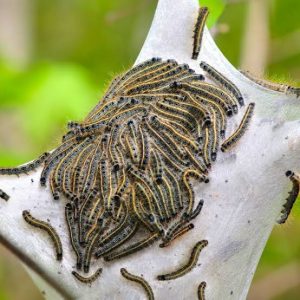Introduction
Quick Navigation
The larvae of some moths and butterflies develop into tent caterpillars. These rapidly developing caterpillars are found in many parts of the United States and Canada, and they are capable of destroying shrubs and trees in a short time. They can be found in neglected gardens and roadside plantations. These larvae produce a large web or tent-like structure on the plant that it invades. The webs serve as a protector to the larvae from predators and other elements.
There are many species of web caterpillar and we’re going to look at four of the most common species:
[BOLD](Fall Webworm)(Hyphantria cunea)
These species are commonly found in Mexico and North America, and they’re known to feed on over 85 species of plants. Unlike tent caterpillars, fall webworms create tents on the other end of branches often including leaves.
The caterpillars, which are usually 1 inch in size, are hairy and vary in color from yellow to green with strips of black on their back and strips of yellow on each side. They’ve red or blackheads. An adult moth of this caterpillar is one inch long, purely white with little spots of black on its back.
[BOLD](Eastern Tent Caterpillar)((Malacosoma americanum)
These species of tent worms are mostly found in the Rockies, Northern, and Southern Parts of Canada. The full-grown caterpillar is about 2 inches in length, black with a row of light blue spots on each side, and sparsely covered with hair. They possess strips of white down the center of their back which is usually used as a means to identify them.
The adults of the Eastern Tent Caterpillar grow into reddish-brown moths with a white band diagonally crossing each wing. They’re usually found on Apple, crab apple, cherry, and other varieties of shady plants.
[BOLD](Forest Tent Caterpillar)(Malacosoma disstria)
These species are found in places with hardwood in the United States and Canada. Unlike other species of tent caterpillar, the Malacosoma disstria doesn’t spin a true tent rather it forms a silken mat on the surface of the plant where it gathers. Their larvae are similar in appearance to Malacosoma americanum but have a series of keyhole-like spots on their back instead of straight lines.
The adults of this caterpillar are light yellow or tan-colored moths of length 1 to 1½ inches. They Have two dark bands on their forewings and invade wide cherry trees, oak trees, hawthorn, and maple.
[BOLD](Western Tent Caterpillar)(Malacosoma californicum)
These species are commonly found in the Northern and Western sides of the United States and adjoining Canada. Their body is covered with hair and they’re about 2 inches long, yellowish-brown with a row of blue spots on their backs & some specks of orange in between.
The adult moth of this species is about 1 inch long, orange-brown colored with two narrow yellow lines on its wings. They are mostly found on cherry, oak, birch, Apple, roses Cottonwood, and Willow trees.
[BOLD](Life cycle of tent caterpillars)
During winter, most species of tent caterpillars lay eggs. The dark brown or gray masses contain nothing less than 150 to 400 eggs and are attached to twigs of trees and shrubs. In early spring when leaf buds start to unfold, the eggs hatch into caterpillars. These tiny organisms will immediately start to make silken tents which they use as a protector during the early morning, evening, and rainy hours.
During the day, they leave their refuge to feed while leaving a silk trail as they crawl to help them find their way back to their protective tent. Roughly six weeks after hatching, and five in stars later, the caterpillars become full-grown larvae, with size ranging from 1 inch to 2 inches depending on species and body covered with hair. Pupation occurs in the silken cocoons that are found on leaf litter, fences, and tree trunks. These larvae travel in thousands to protected areas to pupate and they can be found on driveways, fences, and roads. In about two weeks, the pupa will emerge into a fully grown moth which will soon deposit eggs in the winter period. There’s one generation of tent caterpillars each year.
[BOLD](The Best Time to Remove Tent Caterpillar)
The sight of tent caterpillars is awful as such it’s necessary to remove them. The egg masses can be picked out with the hand. Once leaves drop from trees, you can easily see the small egg cases, while larger nests can be removed by winding them with a long stick.
The best time to remove tent caterpillars is early morning or in the evening, as they’re likely inside the nest by that time. During rainfall is also a good time, as they usually take refuge in the nest once it’s raining. The afternoon isn’t a perfect time for removing a caterpillar nest as you might end up destroying an empty nest because the caterpillars leave their shelter during the day to feed.
[BOLD](How to get Rid of Caterpillar Tents)
When it comes to getting rid of caterpillar tents, there are many methods that you can use to alleviate these nasty little creatures. You can choose to control them or kill them. Below we shall look at some of the best ways to control caterpillar tents
[BOLD](How to Control Caterpillar Tents)
- Check your plants closely if there are any overwintering egg masses. If you find some, scrape them off and destroy them. Also, tear protective tents and destroy them before the larvae start to grow and feed
- Starve the caterpillars by restricting their movement and cut off access to any feeding area using sticky tree bands or pest barriers. Applying insect glue around the trunk of the invaded tree is a good way to do this. Apply the non-drying tree glue around the tree using a spatula or spoon around the tree forming a protective area where caterpillars cannot pass. Make the glued area about 1 inch wide, so that once caterpillars try to pass over it, they’ll get stuck.
- Another good way of controlling tent caterpillars is by using natural tent caterpillar treatments. One of the most commonly used natural sprays is Thuricide. This is a concentrated bacteria that is harmless to humans and animals but kills caterpillars days after they ate plants that it is sprayed on.
This concentrated bacteria can be sprayed on any tree or plant without any fear of danger. Mix a tablespoon of Thuricide with a gallon of water and spray on the targeted plant or tree. Caterpillars will die a few days after feeding on the plant. Re-spray the mixture every two weeks.
- Using Organic Tent caterpillar treatments is also a good way to get rid of tent caterpillars. Especially for those growing organic gardens and will prefer using certified and labeled products on your fruits and vegetables when controlling tent caterpillars. Luckily, few organic products are certified, approved, and proven harmless but effective in killing tent caterpillars. Some of these products use Bacillus Thuringiensis as the active ingredient, and just like Thuricide, caterpillars that feed on plants sprayed with these products will die within 7 to 10 days.
- Spinosad is a biological agent that is derived from fermentation. It is also very effective in controlling caterpillar best and it is used as the active ingredient of some insect sprays
- If all the above aren’t good options to you, consider going to the nearest insecticide shop and buying an effective caterpillar tent killer or controller that I certified and non-hazardous to humans and animals
[BOLD](How to Kill Tent Caterpillars)
At times, the best way to get rid of tent caterpillars is to kill them. Small infestations of these organisms can be killed by thrusting the tent inside soapy water. For larger infestations, you can use insecticide sprays that kill caterpillars instantly while leaving no harm to your plants. Apply these sprays directly to foliage and tents of caterpillars
Conclusion
Tent caterpillars or tent worms aren’t a big threat, rather they’re more of an eyesore and nuisance. However, when their population becomes large, they can defoliate trees, affecting their growth and their looks. This makes it highly necessary to control them.
For more, check out our other articles:
BMC Alpenchallenge AMP ROAD Review‘
BMC Teammachine SLR01 Disc Team Review‘

